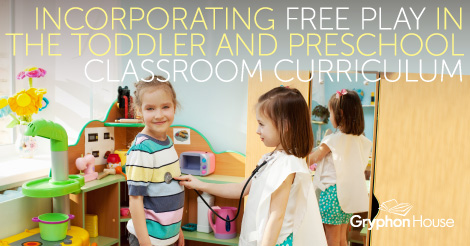
A focus on gross motor development within your preschool classroom is a crucial part of any toddler curriculum. As a teacher, your job is to guide young children and help them discover their mental and physical capabilities so they can reach their full potential. As preschool-aged children rapidly develop, gross motor activities are an excellent way to foster their physical growth, which can impact other areas of development as well.
Encouraging Physical Activity in Preschoolers, by Steve Sanders, EdD, explains just how important gross motor development- found in free play- is to young children. Sanders says that, “just like learning to write, read, or understand numbers, learning motor skills is essential to learning about the world.” Participating in physical activity and learning through movement will help to develop the bodies and minds of your preschoolers.
Free play is exactly what it sounds like: free and unstructured. Simple and easily integrated into classrooms, free play is the most natural step in gross motor development. Allowing your students time to run around and develop their gross motor skills will encourage their sense of curiosity and also improve their grasp on concepts such as social-emotional skills.
While some children are physically unable or uncomfortable participating in free play, it is important to remember to instill the same confidence within them that children who adapt more naturally to free play have. Helping every student embark on a “physical-skill adventure,” even at the most basic level, is key to creating a positive environment for exploration. It is also important to remember that the goal of free play is not to create professional athletes. The goal is to help children develop their basic gross motor skills and create a foundation for physical activity they will use throughout their lives.
Here are a few ways to incorporate free play in your classroom!
Scarves:
Scarves can be thrown, caught, and used in rhythm activities. Lightweight, silk-like scarves fall slowly when tossed, so they will be easier for the child to catch. Scarves for young children are usually 12 to 16 inch squares.
Jump Box:
Jump boxes can be purchased, or you can construct one from ¾-inch plywood. Cut carrying holes in two opposite sides of the box. Make sure all rough edges are sanded. If you like, you can get children to help paint and decorate it. One the side of the box, you can tape photos or clippings of children and adults jumping. You can make the box fancy by attaching a piece of carpet on top for the take-off area. Using ¾-inch plywood will make the box heavy enough that it will not move when children jump off. The box can also be used as an equipment storage container.
Scoops:
Plastic scoops serve as extensions of children’s hands and arms to help develop their catching skills. Homemade scoops can be made from plastic milk jugs. A scoop can really be an advantage if a child is having difficulty catching or has special needs.
Author(s)Steve Sanders, EdD
Anna Wilmoth
Marketer. Publisher. Reporter. Educator. Mother. Runner. Explorer. Anna served as director of marketing for Gryphon House from Oct 2014 - May 2017.

